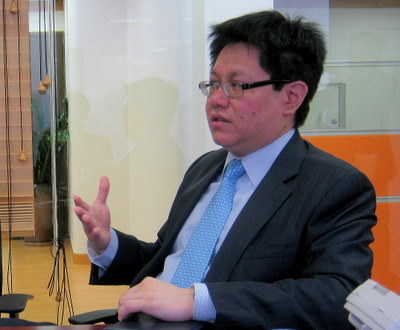
SOLARGIGA ENERGY Holdings Ltd (HK: 757), China’s second largest manufacturer of monocrystalline silicon products, plans to double its annual monocrystalline solar energy conversion capacity to 700 MW by the end of this year.
The company’s chief financial officer, Mr. Jason Chow, recently told NextInsight, Aries Consulting and several Greater China fund managers that the Hong Kong-listed firmis also committed to quality improvements to protect margins in an increasingly cutthroat industry.
He said that the company was steadily moving beyond the recession-hit business environment of 2008 and 2009 and a noticeable pickup in business in the second half as well as high end capacity expansion are pointing to a much sunnier 2010 and beyond for the solar wafer maker.
The company also swung to a first quarter net profit of 10.64 mln yuan after seeing a net loss of 68.6 mln a year earlier.
Looking ahead, Mr. Chow said that in order to cope with the need for expanding capacity, Solargiga will gradually complete the construction of a new plant that can accommodate 200 monocrystalline ingot pullers, 40 wiresaws and modules with a capacity of 100 MW.
The company, based in the northeastern province of Liaoning, is also targeting to increase the number of its facilities to 397 monocrystalline ingot pullers and 80 wiresaws in 2010, and by then the annual production capacity will surge to 4,000 tonnes of monocrystalline silicon solar ingots and approximately 150 mln monocrystalline silicon solar wafers.
“Annual production capacity of multicrystalline silicon solar wafers will be increased to 500 tonnes. With the gradual completion of the expansion plan this year we will double the reference value of our existing annual monocrystalline solar energy conversion capacity, from 350 MW to 700 MW,” Mr. Chow said.
“All these planned expansions should be completed in the second half of this year. We want to be No.1 in monocrystalline. We are also aiming to build a vertically-integrated business model from ingots to system installation. We took the first step in 2009 and moved downstream into panels and system installation.”
Twofold Margin-boosting Strategy

China’s solar ingot and wafer industry, like the more downstream panel sector, was decidedly fragmented and therefore increasingly competitive.
It was therefore all the more incumbent upon listed firms in the sector to maximize profits and shareholder returns by fighting to keep margins healthy, whether by cutting costs or raising selling prices.
Solargiga was doing both, and very successfully so.
“Silicon ingot and wafer costs took a big hit, especially at the end of 2008 and the first half of 2009. But they are gradually recovering and our recent results show this.
“Additionally, we will continue to lower production costs to improve margins” he said.
Solargiga, China’s No.2 maker of monocrystalline silicon products, was realistic about the direction of the industry, but was making preparations well in advance to meet potential challenges both down the road and down the production chain.
|
|||||||||||||||
“In a buyer’s market, we can’t expect that going forward we can continually enjoy 40% margins for wafers. There is simply too much competition and too many players, both established and new. But we can control our selling prices and the higher up the quality chain we go, the higher ASPs we can command. Quality is our number one concern,” he said.
In 2009, over 70% of Solargiga’s revenue are from local origin, but the Group is aiming at increasing the contribution from overseas.
Solargiga was beginning to make forays into the US market since 2009, which now contributed around 20% to its sales revenue from a base of zero just a short time ago.
As Solargiga’s stance on the much-publicized frictions between Chinese solar energy-related firms and North American and European markets, the company maintained a pragmatic outlook.
“Yes, there is periodic tension here. We hope problems are resolved quickly because we of course want to avoid wildly fluctuating margins, which trade action can give way to. Ironically, some of our biggest critics are German companies while at the same time our biggest clients are also in that country,” he said.
He also said that Solargiga “keeps an eye on" wind, hydroelectric and even nuclear power firms, but that at the end of the day, the primary competition came from other ingot and wafer makers – especially domestic Chinese firms.
“Solar power is more expensive than wind, but our main raw materials – silicon – are plentiful in our earth, so supplies are not a problem like those facing nuclear power plants. Also, solar power facilities have a much longer shelf life than wind because we have no moving parts so replacement and repair costs are virtually nonexistent. Only the sun moves in our sector.
“We also have no emissions or waste, which can’t be said for nuclear and certainly not for traditional coal-fired plants.”
|
|||||||||||||||||||||
China relies on the burning of coal for over 70% of its energy needs, one of the highest rates in the world and a chief cause of the country’s air quality woes.
And with the environmental costs of coal and the political risks inherent in securing steady flows of oil from often unsteady regions around the world, Beijing is definitely pro-solar.
However, Mr. Chow and Solargiga were more interested in policy support than handouts.
“We would prefer to see a supportive environment for our industry rather than raw subsidies. This will make it more viable and sustainable over the long term. Also, our climb up the quality ladder means we are far less likely to face mandated capacity cuts in national campaigns to consolidate production amid fragmentation. This is definitely our strong point.
"Also, solar energy only produces less than 1% of the world's power, so there is huge growth potential."
See also: CHINA ENVIRONMENT CEO says 99% of Chinese polluters need products like his







